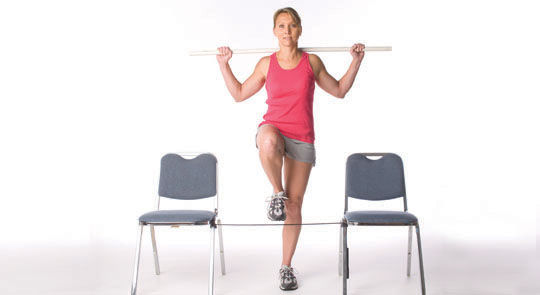
By Justin Price, M.A.
Look for the final article in this series in the March 2012 issue, which will detail more static assessments you can use to identify musculoskeletal imbalances and specific exercises to help correct them.
In the first article in this three-part series on corrective exercise (The Importance of Conducting The Right Assessments), you learned about the importance of conducting a static postural assessment with every client to help uncover the potential causes of your clients’ aches and pains. You also learned how the common deviation of excessive lumbar lordosis can affect the function of the entire body, as well as how to assess the lumbar spine to evaluate whether a client has that deviation. In this article, you will learn two more postural assessments for the feet/ankles and thoracic spine. These assessments can also be used to uncover musculoskeletal deviations that commonly cause people to experience pain. In addition to these assessment techniques, you will also learn an array of easy and effective strategies that you can use to help clients alleviate pain and improve function.
Common Complaints
The musculoskeletal system experiences continual stress and strain as it works to dissipate gravity and ground-reaction forces (i.e., impact) throughout the body (Chasan, 2002). If any part of the body is out of alignment, other areas must compensate to deal with these ever-present forces of nature. For example, if the lower back arches too much, the pelvis tilts forward to help the body maintain a balanced center of gravity. These compensation patterns can lead to overuse of muscles and soft-tissue structures and cause pain to certain areas of the body (American Council on Exercise, 2010). Eventually, these compensation patterns may manifest in clients as problems such as Achilles tendonitis, plantar fasciitis, patella femoral syndrome, runner’s knee, hip bursitis or dysplasia, spinal disc degeneration, sacroiliac joint dysfunction, rotator cuff tendonitis and/or tension headaches (Petty and Moore, 2001). Regardless of the specific problem, the cause of most of these conditions stems from misalignment somewhere in the musculoskeletal system. Therefore, although it is beyond our scope of practice as personal trainers to diagnose a specific ailment, it is possible and acceptable for us to assess a client’s posture to evaluate whether musculoskeletal imbalances play a part in the painful symptoms they experience. Furthermore, we can use the results of these assessments to design and utilize corrective exercises to get a person’s body back in alignment and reduce or eliminate the incidence of their various symptoms.
Simple and Effective Assessments Strategies
Postural assessments do not have to be time-consuming or complex. In fact, there are many quick, yet effective assessments you can use to help determine whether a person has a musculoskeletal issue that may be causing them pain. Following are two such assessments—one for the feet and ankles and one for the mid-upper back (i.e., thoracic spine)—that enable you to evaluate clients quickly for problematic postural deviations.
Foot and Ankle Assessment
This is an easy assessment to determine whether a person overpronates at the foot and ankle. Overpronation is a common postural deviation that can cause foot, ankle, knee and hip pain.
Ask your client to stand in front of you with the feet facing forward. Look at the area where the foot joins the ankle and locate the two small indentations at the base of the ankle just below the ankle joint (i.e., there is one on the inside of the ankle joint and one on the outside of the joint). Place your thumb on the dimple on the inside of the ankle and your forefinger on the dimple on the outside (Figure 1). Ask your client to roll the foot and ankle inward (overpronate). You will feel the pressure on your thumb increase. Ask the client to roll outward (oversupinate) and you will feel pressure on your forefinger increase. This pressure is the talus bone moving inside the ankle joint. Coach your client to pronate and supinate several times so you can get a good indication of the feeling of pressure from the talus bone on your thumb and finger. When you feel even pressure of the talus bone on both your thumb and forefinger, coach the client to stop pronating/supinating and hold that pose. This position that the client is now holding is the anatomical neutral position for the foot and ankle. You will find that most people will have to supinate to get to a neutral position; this is indicative that the client is a habitual overpronator.
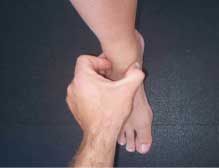
Figure 1: Foot and Ankle Assessment
Thoracic Spine AssessmentThis assessment can be used to determine whether a person has excessive thoracic kyphosis (i.e., excessive rounding of the upper torso), which can cause shoulder pain, neck pain, headaches and back pain.
Ask your client to stand in front of you facing side-on and look at his or her neck and shoulders. Draw an imaginary line from the spot where the first rib meets the sternum on the front of the torso to the first thoracic vertebrae on the back of the torso to evaluate the position of the client’s sternum and ribcage (Figure 2). The line from the top of the breastbone to the first thoracic vertebra should be parallel with the floor. If it is not, it means that the ribcage has dropped down and forward, resulting in an overly rounded thoracic spine (i.e., excessive thoracic kyphosis).

Figure 2: Thoracic Spine Assessment
There are many more postural assessments you can utilize for the knees, hips, pelvis, shoulder girdle, arms, head and neck to help you pinpoint the cause of a person’s aches and pains (Price and Bratcher, 2010; Kendall, 2005). It is highly recommended that you familiarize yourself with a structured approach to conducting static assessments so you can be selective in choosing effective corrective exercises.
Five Exercises to Help Eliminate Pain
The following exercises can be used to help recondition soft-tissue structures that are commonly negatively affected by the imbalances previously discussed.
Calf Massage
Overpronation can cause tight calf muscles. A calf massage can help rejuvenate the posterior calf muscles (e.g., soleus and gastrocnemius) and enable the foot and ankle to function more effectively (Figure 3). Massage across and up and down the muscle, targeting knots and/or adhesions. Massage each calf one to two minutes at least once per day.

Figure 3: Calf Massage
Hip-flexor Stretch (With Activation of Gluteus Maximus)The hip-flexor muscles run from the lumbar spine across the pelvis and attach to the top of the leg. Stretching these muscles enables the hips to extend (i.e., move forward) under the spine so the lower back does not have to overcompensate by arching excessively to hold the torso upright (Figure 4).
Kneel with one leg in front of the other. Posteriorly tilt the pelvis (i.e., tuck under) until you feel the glutes of the back leg contract. Keep the torso erect without arching the lower back excessively. Hold for 30 seconds on each side.
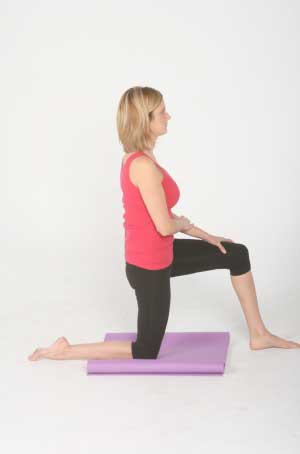
Figure 4: Hip Flexor Stretch
Foam Roller on Thoracic Spine
Excessive thoracic kyphosis creates muscle tension and fascial restrictions in the soft tissue structures of the thoracic spine and upper torso (e.g., erector spinae muscles, traps, neck extensors). This self-myofascial release exercise will help release tension in these tissues to enable the thoracic spine to extend (Figure 5).
Lie back over the foam roller with head supported and posteriorly tilt (i.e., tuck under) the pelvis to help reduce the tendency to arch the lower back. Roll from the mid-back up to the shoulders, being careful not to hold the breath. Perform for two to three minutes every day.
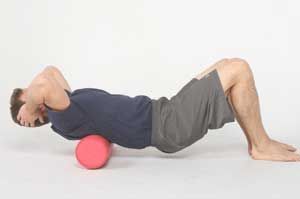
Figure 5: Foam Roller on Thoracic Spine
Straight Arm Raise
Strengthening the muscles of the upper back can teach the body how to utilize the muscles of the thoracic spine to lift the torso upright so that the structures of the lower back do not get overworked (Figure 6).
Lie on the ground with the knees bent and lower back flat. Raise the arms overhead until they reach the ground. Pull the arms down into the floor without arching the lower back, shrugging the shoulders or bending the arms. Hold for 20 seconds and repeat three times.

Figure 6: Straight Arm Raise
Step Back With Arm Raise
This integrated stretching and strengthening exercise helps stretch the hip flexors, calf muscles and abdominals while strengthening the gluteal muscles and the thoracic extensors to help extend the hips and erect the spine (Figure 7).
Step back with the right leg as the right arm swings up in line with the ear. Engage the right gluteal muscles to push the hips forward. Be sure to extend the thoracic spine and don’t overarch the lower back. Switch arms and legs and perform three to five repetitions on each side.
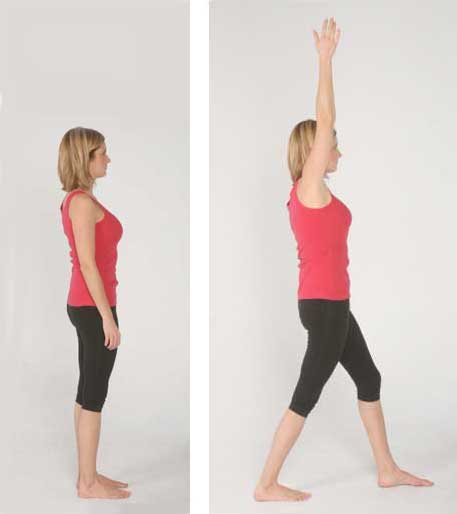
Figure 7: Step Back With Arm Raise
Conclusion
Utilizing a structured and strategic approach to assessing the five key areas of the body (i.e., feet and ankles, knees, lumbo-pelvis hip girdle, thoracic spine and shoulder girdle, and neck and head) can give you valuable insight into which area(s) of your client’s body are most out of alignment or imbalanced. You can then implement simple, yet effective corrective exercise strategies to help address these imbalances to alleviate the person’s pain. You can also help coach your client to understand the ill effects that poor static postural positions can have on the body (see sidebar, “Static Postures That Can Cause Pain”). In the third and final article in this series, you will learn even more corrective exercises and how you can incorporate these techniques into fun and rewarding personal-training programs.
Static Postures That Can Cause PainMany environmental factors can contribute to musculoskeletal imbalances. Here are a few things to consider when teaching your clients how to alleviate their aches and pains.
- Sitting for prolonged periods causes the spine to round and the musculature of the hips and pelvis to become inflexible. Help clients reduce negative musculoskeletal impact of prolonged sitting by encouraging them to get up out of their chairs several times a day to promote spine and hip extension. You might also suggest that they convert their workstations to a stand-up desk.
- Standing with bad posture for prolonged periods can also cause painful compensations. You can help clients minimize aches and pains caused by prolonged standing with poor posture by making them aware of individual habits like shifting their weight from side to side, crossing their arms, talking on their cell phone or carrying a heavy bag on one shoulder.
- Sleeping on a bad mattress or in unusual positions can also negatively affect musculoskeletal health. Coach clients to sleep on their backs on a mattress firm enough so that neither the lower back nor thoracic spine sinks into the mattress. If a client feels uncomfortable in this position, recommend placing a wedge or pillow(s) under the knees to help posteriorly tilt the pelvis to take pressure off the lower back. Encourage clients to start off in this position for just a few minutes a night and gradually increase the amount of time spent in that position. As the structures of the lumbar spine begin to adjust, the client can reduce the height of the pillows under the knees. If a client insists on sleeping on his or her side, recommend placing a pillow between the knees to help keep the leg in line with the hip socket. The pillow used for the head should be thick enough to keep the head in line with the spine.
References
American Council on Exercise (2010). ACE Personal Trainer Manual (4th ed.). American Council on Exercise.
Chasan, N. (2002). Total Conditioning for Golfers. The Swing Reaction System -- Biomechanical Golf Fitness Program. Bellevue, Wash.: Sports Reaction Productions.
Kendall, F.P. et al. (2005). Muscles: Testing and Function with Posture and Pain (5th ed.). Baltimore, Md.: Wolters Kluwer Lippincott Williams & Wilkins.
Petty, N. and Moore, A. (2001). Neuromuscular Examination and Assessment: A Handbook for Therapists. Edinburgh, Scotland: Churchill Livingstone.
Price, J. and Bratcher, M. (2010). The BioMechanics Method (Level One).
_________________________________________________________________________

Justin Price, M.A., is a subject-matter expert for the American Council on Exercise on structural assessment and corrective exercise, and the creator of The BioMechanics Method, which provides corrective exercise education for health and fitness professionals. He is also an IDEA Personal Trainer of the Year and an education provider for PTontheNet, PTA Global and the National Strength and Conditioning Association.